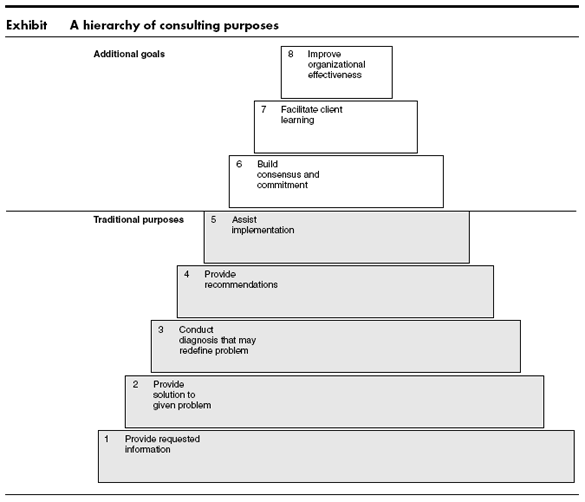The phrase “A Hierarchy of Purposes” is a term that our company extracted from an article written by Arthur N. Turner for the Harvard Business Review in September 1982. In the article, “Consulting Is More Than Giving Advice”, an exhibit of a hierarchy of consulting purposes was posted. Our company, SG Business Advisory Pte Ltd, pins our methodology based on the hierarchy that was first elucidated in the article. In this blog post, I will try to share our methodology based on this hierarchy to let our readers better understand how our company employs “A Hierarchy of Purposes” on our projects.
To most, consulting is about giving advice. However, consulting is truly more than giving advice. That is if the said consultant has a proper framework to base his work upon. Without a proper framework, the approach that a particular consultant will be haphazard. In many cases, the approach is piecemeal. The consultant would take unsystematic partial measures over a period of time. As we have frequently mentioned, not every company will need a rebranding exercise. Some will, and some won’t. The truth is that many profitable companies, and in some cases, unprofitable ones, only require certain tweaks to their working structure to function more efficiently. Miniscule as some would like to think of it as minor tweaks can have a major impact. Think of pricing for that matter, a small increase at the gas station can reverberate throughout the economy. Yet there are instances where certain luxury brands have been known to increase their prices and yet demand for that particular product remained constant, and in some cases, increased. This would require an individual who is well versed in the elasticities of demand to better understand the impact of price changes. This is why when companies want to set pricing for their products, they do consult consultants. Bring that thinking down to a local cafe. The decision to increase the price of a cup of coffee by a mere 50 cents may cause customers to veer away from that cafe’s coffee to another cafe just down the same street. This is where you need the proper research and critical thinking portion of the decision making to come in. A simple permutation whereby we are operating as one cafe versus a chain of say 20 cafes scattered across Singapore also changes the decision greatly. Increasing the price across the board may negatively affect the demand in 5 cafes but then increase the overall profitability of the remaining 15. In this case, as you are running the cafes as a chain of cafes, you cannot vary your prices across the various outlets. The decision there would be whether to split the brand into two. i.e. a premium one and a mass-market one. Many brands have done it. Albeit to varying degrees of success. Aston has Astons, Astons Specialities, Astons Steak & Salad and Andes by Astons.
So where do we draw the line? How do we start? The truth is, we need a framework to base our starting and ending points. We cannot think where the problem lies and perhaps hope that that is it. Also, all problems with profitability do not all emanate from poor brand identity. This is where our company, and myself especially, have found that having a proper framework does help in isolating the key issues in various companies. As stated in Arthur N. Turner’s article, “Perhaps a more useful way of analyzing the process is to consider its purposes; clarity about goals certainly influences an engagement’s success. Here are consulting’s eight fundamental objectives, arranged hierarchically”

A Hierarchy of Purposes (Source: Harvard Business Review)
The numbers are labelled in levels of difficulty and complexity. The lower the number the more understood and practised. i.e., most consultants would be able to clear the items labelled with the lower numbers. Purposes 1 to 5 are generally considered traditional purposes with goals 6 to 8 as something that clients are less likely to request but the mark of a good consulting project should strike to hit these goals. Moving up the pyramid requires a more in-depth analysis of the situation by the consultant. The level of sophistication and skill required in the process is a lot higher. As mentioned by Arthur, some firms may have lost track of the line between what is best for the client and what is best for the consultant’s business. An example of this would be if a consultant were to be very well versed in branding. However, after looking through the company’s issues, the key issue is the lack of proper work processes. It is more probable that solving the work processes issue would result in better revenues as compared to working on a rebranding exercise. However, the consultant still recommends the branding exercise ahead of working on refining work processes and creating standard operating procedures for the workplace. The result may be that the branding exercise results in an increase in revenue. However, if the time and effort were spent on solving the work processes issue, there would be an even higher increase in revenue. In this case, the consultant chose the route that he or she is more familiar with. Not what the client truly needed.
Therefore, it is key for a consultant to go through a fixed methodology when working with a client. This is key to our company and practice and this is why we employ A Hierarchy of Purposes.
1) Provide requested information
This is perhaps the genesis of every consulting project. The consultant would be in charge of obtaining information. Compiling the required information might involve doing surveys, feasibility studies, and speaking with the relevant stakeholders and market experts. No one consultant can know every type of business. However, a good consultant should always be very well versed in compiling information. Often information is what the client wants. “How well received is my new product?” might be the question and this information cannot be obtained sitting behind the desk coming up with information from previously researched journals or market research. Instead, the appropriate thing to do is to commission for a survey. Go down to the streets to interview, collect feedback through survey. Then compile the information in a digestible manner for the client taking into account any possible bias in the data. That is collating information.
2) Provide solution to the problem
The problems posed are often very complex and extremely tedious to work on. This is the reason why clients hire consultants. The problem might be a decision whether or not to expand into another country, whether to adopt a new line of product or to reorganise the organisation. As a consultant, one must think of the reasons why the client engaged us. In the majority of cases, the reason for engaging a consultant would be because the company either does not have the relevant personnel to work on the problem or the company personnel does not have the time to solve the problem. Most probably the issue would have already reared its ugly head by the time a consultant is brought to the table. However, the consultant must also be wary that the problem might not be what the client thinks it is. For example, we had a client that requested for her food and beverage operations to undergo a major overhaul in terms of branding. When we asked the client why she had such a motivation to do so, she remarked that the revenues of the set up had plateaued. However, on careful observation, we realised that it was not because of her branding that was preventing her outlet from generating more revenue. It was because the staff were too slow in serving takeaway orders such that customers that were far behind in the queue simply gave up queuing. This was happening on a daily basis. How did we know this? We just sat at the outlet and observed the operations for a couple of days.
3) Conduct diagnosis that might redefine the problem
The last point brings us nicely to this point about effective diagnosis. Much of a consultant’s value lies in the fact that he or she can effectively diagnose the issues that plague the client’s company. In many cases, it is more efficient for the company to engage an external consultant than to rely on internal managers to uncover difficult situations. The reason for this is usually fear. Internal managers might fear bringing up issues to the decision makers in an organisation. This is perhaps more prevalent in an Asian society like Singapore where hierarchy still plays a significant role in corporate culture. Hence getting a consultant in would effectively remove this fear or awkwardness. The consultant, if given the appropriate autonomy, can then effectively diagnose the problems that plague the organisation. The diagnosis should range from less serious to very serious. It should also come with a basis of diagnosis that is backed with the relevant data. Often we will see that the problem that the client initially thought might not be the main problem once a decently competent consultant has effectively diagnosed the problem.
4) Provide recommendations
This is the portion of the engagement that the consultant will present either a written or oral report to the client. This presentation effectively summarises what the consultant has compiled and learned from his interaction with the relevant stakeholders as well as his analysis of the data collected. Consulting firms focus a significant deal of time and effort to design their reports so that the information and analysis is presented in a manner which is convincing and clear to the client. This would also include a logical plan as to how to solve the identified problems coupled with detailed steps to take. In some cases, the consulting process ends here. The client may choose to implement the changes within his organisation on his own. However, in many cases, the client would prefer the consultant to stay on throughout the implementation phase.
5) Assist implementation
The keyword is “assist”. Clients have to be aware that the consultant should not have the authority to come in and take over the chief operating officer’s (CEO’s) role. Instead, the consultant should be working with the CEO to implement the relevant changes to the company. The work should be in tandem with the relevant stakeholders. Not over them. In certain cases, the consultant may engage third party vendors to assist with the implementation. For example, a client of ours who runs a restaurant was undergoing a digital transformation project which we were implementing. One of the key aspects of this was to implement QR codes on the dining tables so that ordering and payment can be done through the website that would pop up when customers scanned the QR code. This involved the installation of a brand new point of sale system as well as a new billing system on top of the printing of the QR codes. Our firm is not well equipped at that point in time to work on these items and we engaged the relevant third-party vendors to help with the implementation and installation.
This then concludes the traditional purposes of the hierarchy of purposes framework. This is typically where a management consultant might end. There is, however, an additional few steps for us to consider. In our opinion, this is what sets an excellent management consultant from the rest of the field.
6) Build consensus and commitment
The recommendation and implementation will only be useful if there is widespread adoption within the organisation. The recommendations can be spot on. The issues are well identified and diagnosed and the solutions all meet what is needed for the issues. Implementation is also done organisation-wide according to what is recommended. However, if the stakeholders, i.e. the ones who are going to be most affected by the changes, do not buy into the recommendations and implementation of the changes, then the effectiveness of the exercise will be lost. The key is establishing enough consensus within the organisation that such implementation makes good sense. It is not about getting the client to move but garnering enough support within the organisation for the implementation to be successful.
Here are a few pointers that a consultant may consider in gauging a client’s readiness and commitment to the project/
- During the consultation process, did the client resist any of the suggestions?
- During any stage of the process, was there any form of information that was particularly difficult to retrieve from the client?
- Is there good synergy between decision-makers and the rest of the company?
- How long has the current system been in place?
- How long have the current stakeholders been doing their jobs in the current state?
- Throughout the various stages of the process, was the enthusiasm level high or weak?
- To what extent will the project improve the work processes and how desirable is the objective that the project is trying to achieve?
A good consultant will know how to spot issues and try to kindle enthusiasm. Usually, an ally from within the organisation would be helpful. It would be most ideal if an ally can be identified in each department of the company and these individuals will help the consultant to drum up support for the project.
7) Facilitate Client Learning
A good management consultant leaves behind more than just an impact based on that one particular project. A good consultant will enhance and enable clients to cope with future issues as well. The consultant can direct the organisation to where they can find information to implement the required processes to solve future issues. It is going back to the popular mantra that it is better to teach a man to fish than to provide him with the fish itself. While some may think that this puts the consultant in a position where his clients are going to give him less work, the flip side is that his clients are going to grow in terms of organisational size and revenue. This inevitably will result in a new host of issues that they will have to deal with when it comes to growing. Such success stories only tend to improve a consultant’s profile, leading to an increase in referrals. Such growth may also bring along issues which will require the management consultants to step back into the fray.
8) Improve Organisational Effectiveness
“The term organisational effectiveness implies the ability to adapt future strategy and behaviour to environmental change and to optimise the contribution of the organisation’s human resources.” While this is a mouthful that we’ve lifted directly from Arthur’s article, what it means is for an organisation to remain effective even as the business environment changes. This is perhaps the holy grail of management consulting. This is when the organisation reaches a point where it can quickly adapt to changes to survive and thrive. An example of this would be the recent Covid-19 pandemic which changed the way companies work. It also accelerated the digitisation process of individual companies. The organisations which were able to pivot and reinvent themselves were able to be the first movers in the virtual and digital sphere. Such organisational effectiveness should be the holy grail for most companies. This can only be achieved with an effective system and culture set in place.
If your company is looking to grow and innovate or would like to know what possible grants are available, do email me at [email protected].
Yours sincerely,
Daryl






